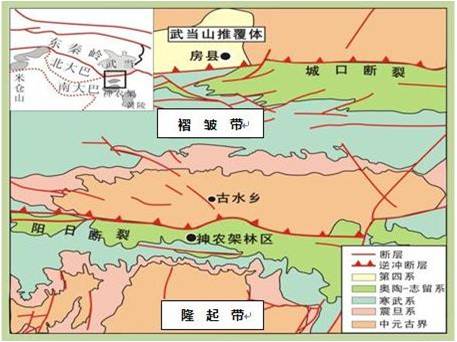Development and Evolution History of Regional Geological Structures
Updated:2022-09-20 Source:Shennongjia National Park
During the Indosinian movement of the Middle and Late Triassic, comprehensive continental collision occurred in the Qinling orogenic belt, forming the basic structural framework of the NWW-trending structural belt of the central orogenic belt. In addition, ductile shear deformation occurred in the Wudang Group on the north side of the Shennongjia (Cai Xuelin, Fang Xiangchi, et al.). The stretching lineation indicates that the direction of the maximum principal stress is near the S-N direction. Influenced by the Indosinian orogeny of the Qinling orogenic belt, under the action of the near S-N principal compressive stress field, the Paleozoic-Triassic strata in the Shennongjia area in the eastern part of the Dabashan foreland structural belt were involved in the deformation, forming a series of near E-W fold structures. Thus, the tectonic pattern of the Shennongjia area was preliminarily established. During the Early Yanshanian movement in the Middle and Late Jurassic, on the basis of inheriting the Indosinian fold and deformation, under the influence of intracontinental orogeny in the Daba Mountains, the Shennongjia area in the eastern part of the Dabashan foreland structural belt was still compressed in a near S-N direction. Under its action, a series of east-west fold structures have been formed in the Shennongjia area, and the pre-existing Indosinian fold structures have been transformed to form a combination pattern of fault-cut fold structures, and even an interference pattern of "coaxial" superimposed folds in local areas.

The study shows that the Middle-Late Jurassic strata are absent or only sparsely distributed in the Yangtze plate where the study area is located, indicating that the study area was in a strong compressional collision orogeny process in the Middle-Late Jurassic.
Due to the influence of Jurassic intracontinental orogeny, the Shennongjia-Huangling stable and rigid block began to uplift (160-95 Ma) and the surrounding caprock of the Shennongjia uplift was strongly deformed, resulting in the formation of a series of fold structures. On the eastern margin of the uplift, a series of NE-trending structures are formed between the two rigid blocks due to the extrusion of two rigid blocks in opposite directions, and the direction of the maximum horizontal principal compressive stress field changes from S-N to NW-SE. During the development of the Dabashan foreland structural belt, a series of skirt-like fold structures were formed on the western margin of the uplift due to the restriction of the Shennongjia-Huangling rigid block. The Shennongjia uplift also restricted the extension of the Xuefengshan arc structure, so the skirt-like fold structures also developed in the southern margin of the uplift. It is the "blocking" effect of this special "structural knot" on the Daba Mountain Arc and the Xuefeng Mountain Arc that leads to the union of two different arc tectonic systems near the "structural knot". The Himalayan Movement inherited the characteristics of the Yanshanian Movement. Since the Quaternary, the Shennongjia area has been in a large-scale uneven and intermittent upward movement, which is manifested as planation surfaces, layered karst and multistage river terraces. Under the action of endogenic and exogenic geological agents, the present geological and geomorphological landscape of the area is gradually formed.

Copyright Shennongjia National Park
Address:36 Chulin Road, Muyu Town, Shennongjia Forestry District, Hubei Province 鄂ICP备18005077号-3
Address:36 Chulin Road, Muyu Town, Shennongjia Forestry District, Hubei Province 鄂ICP备18005077号-3
Email:2673990569@qq.com
Phone:0719-3453368
Phone:0719-3453368


TOP

